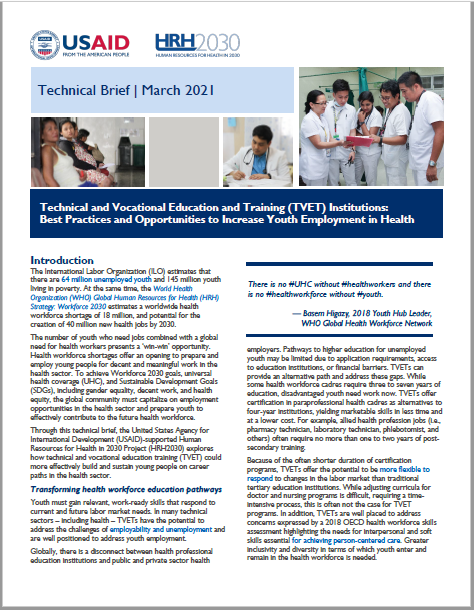17 Mar Technical and Vocational Education and Training (TVET) Institutions: Best Practices and Opportunities to Increase Youth Employment in Health
 Comparing the global estimates of the millions of unemployed youth with the health workforce shortage of 18 million professionals reveals a “win-win” opportunity: Well-skilled youth with specialized training in health are a potential solution to fill the gap in the health workforce. Worldwide, technical and vocational education and training institutions (TVETs) offer certification in paraprofessional health cadres as alternatives to four-year institutions, and confer specific, marketable skills in a shorter period and often at a lower cost.
Comparing the global estimates of the millions of unemployed youth with the health workforce shortage of 18 million professionals reveals a “win-win” opportunity: Well-skilled youth with specialized training in health are a potential solution to fill the gap in the health workforce. Worldwide, technical and vocational education and training institutions (TVETs) offer certification in paraprofessional health cadres as alternatives to four-year institutions, and confer specific, marketable skills in a shorter period and often at a lower cost.
This technical brief explores how TVETs could more effectively build and sustain young people on career paths in the health sector, using the HRH2030-developed Youth Employment in Health Framework. The brief examines the best practices and promising partnerships for TVETs and health employers, citing research from the World Health Organization, as well as specific examples from the private and public sectors that address barriers to youth engagement, support an enabling environment for successful health training and careers, and improve youth graduates’ competencies and skills to better meet market demands. Its key takeaways: Educators, employers, government, and youth are dependent on one another to ensure mutual success, with youth dependent on educators and institutions preparing them for the workforce; employers equally dependent on these institutions for youth with work-ready skills; and institutions relying on the public sector for funding and supportive policies to equip the future health workforce with the training they need to gain decent work.
In addition to this technical brief, HRH2030 developed a case study analysis of the Youth Employment in Health Framework in Indonesia. The case study, Opportunities for Increasing Youth Employment in Health in Indonesia, can be accessed here.
Associated content:
Case Study: Opportunities for Increasing Youth Employment in Health in Indonesia
Materials from the 2019 Global Youth Economic Opportunities Summit
Building the Future Health Workforce 2030: Opportunities for Youth Employment in Health (from the 2018 Global Youth Economic Summit)
Blog: Let’s Transform Health Professional Education to Better Serve Our Youth and Communities
Country: Global, Indonesia
Resource Type: Case study
Topic: Skill mix and competency
DOWNLOAD





